

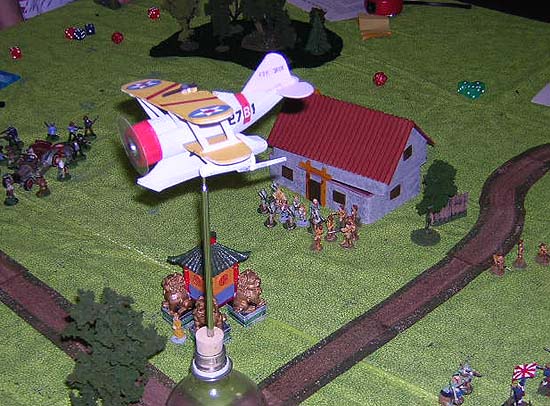
Photo by Ed Sansing
The American float plane makes repeated "strafing" runs at one of the Chinese units, persuading them to scatter, while the U.S. Sailors stole the Chinese Field gun. John Hesselberg scratchbuilt the plane.
Another of the Jackson Gamers' Adventure in 1920s China
Just a Vulgar Brawl
This game was played on August 6, 2005. We used a modified version of Larry Brom's The Sword and The Flame rules called The Sword to Adventure.
There were lots of different factions here, villages, communists, warlord troops, a British Motor patrol, TWO groups of armed US Navymen - sprinkled with Marines, Japanese armed sailors and the mercenary forces of the Standard Oil Company. What we did not have was enough Chinese. If we game in China we need lots of...
We only two units of Chinese warlord troops, one of unit of Chinese civilians, only 5 men strong and a 20-man unit of communists (dressed in red!). We also had two units of American Sailors, (1 of 20 men, one of 12 men) One unit of U.S. Marines, reinforced with bullies from Standard Oil, a 20-man British Ghurka unit, an archeological digging party with rolls Royce, fossils, and hired tough guys, a newsreel camera crew, a madam and her girls, a kidnapped U.S. sailor (in a rickshaw) and two US gunboats with a float plane.

Photo by Ed Sansing
Some of the players at the start of the game. Left to right, Jim Pitts, Phil Young, Sean Pitts, Mike Todd. In this game, everybody was out for himself, to earn money by stealing weapons, automobiles, women and other valuables.
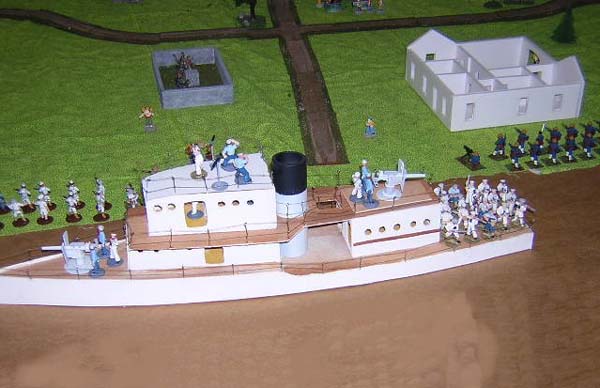
Photo by Ed Sansing
One of two U.S. Gunboats, scratchbuilt by John Hesselberg. The gunboat commander was itching to "let go" with his 4" guns, but was only able to send his sailors ashore as "Peacekeepers."
I decided that this was a “peacekeeping expedition” and everybody fought it out with bare knuckles and rifle butts, no shooting allowed. Everything had a value, expressed in Monopoly money bills. A machine gun was worth nothing if it belonged to you, but if you could steal it from somebody else, it could be sold after the game on the black market for $100. A field gun was worth $500. Automobiles/trucks were worth a D6 x $100. The newsreel crew would pay a $500 ransom, and the drunken sailor was worth $50.
There was also a shrine to be looted, the cash box at the Standard oil concession to be robbed, gold tombstone decorations to be pried off, and a few other small $$ amounts to be picked up around the table.

Photo by Ed Sansing
The smaller U.S. gunboat which acted as "tender" to the floatplane.
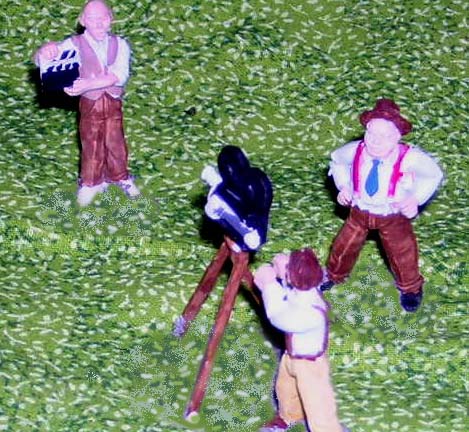
Photo by Ed Sansing
L.M. Bayer's camera crew. These were taken under the "protection" of a group of U.S. Sailors which released them at the end of the game after a large cash payment changed hands.
All of the US Sailors, Marines, and the Ghurkas were presumed to be really led by scheming petty officers or gunnery sergeants (a’la Sgt Bilko) with their befuddled officers being bamboozled by the NCOs who looked at everything with $$$$ in their eyes. Everyone was out for money - which could be gotten by stealing things. Each turn the players with US Sailors, Marines, or Ghurkas had to roll a D10 and if the result was a "10", then the officer reasserted himself and ordered something silly and honorable that turn (the nearest “enemy” player got to move them on that turn).
At the end of the game, the umpire (Jay Stribling) paid each player in "Monopoly Money" according to things that they had "aquired." Chinese Field pieces were worth $500 on the black market. Automobiles, Machine guns, all could be sold for cash at game's end.

Photo by Ed Sansing
The float plane taxying back to it's tender after having to make a sudden landing.

Photo by Ed Sansing
U.S. sailors go ashore to help "Pacification" efforts by Marines and foreign troops.
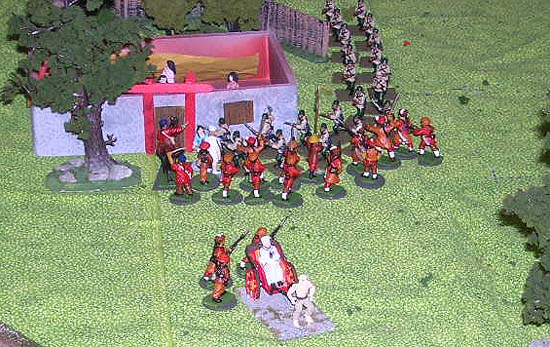
Photo by Ed Sansing
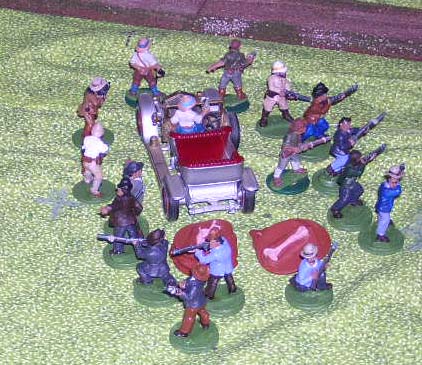
Photo by Ed Sansing
The Players
|

Photo by Ed Sansing
A different view of the Float plane in flight. Every turn the umpire made the pilot roll a D20 and if a "20" was the result, then the plane was forced back down due to lack of fuel, or more likely, contaminated Gasolene.
This happened once, and the next turn the machine was serviced, returning to the air on the next possible turn.
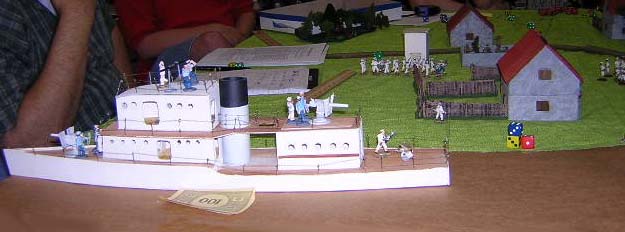
Photo by Ed Sansing
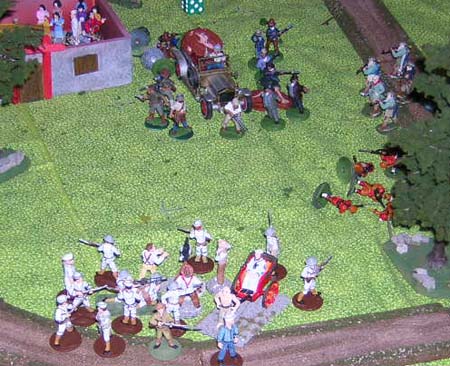
Photo by Ed Sansing

Photo by Ed Sansing
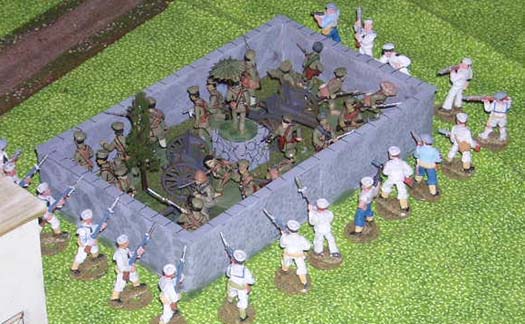
Photo by Ed Sansing
Some rules changes from the standard The Sword and The Flame
Since we had eight factions on the board, sequencing the game did not seem to fall within the standard "Imperialists move on red cards and natives move on black". We grouped the players into four pairs which were well separated, so that they should not interact. If they did, a simple die roll resolved "who moves first".
John Stanger and Fred diamond moved on diamonds. Sean Pitts and Jay Booth moved on Hearts, Jim Pitts and John Hesselhof moved on Spades, and Mike Todd and Ed Pitts moved on clubs. We pulled cards from the deck till everyone had been allowed to move. Then we resolved all close combats. No shooting in this "peacekeeping expedition."
In addition we used 10-20 man units, with one U.S. sailor unit having 24 men. This seemed to work very well, Most players had two or three units in their "command" along with a machine gun or artillery piece. Various small groups of peasants were gamed by the umpire.

Photo by Ed Sansing

Photo by Ed Sansing
The U.S. Floatplane buzzes over the center of the table. The whorehouse is just obscured under the plane's tail but you can see a knot of struggling figures at the door, easily defeated by the Ghurkas inside, who were "protecting" the girls. U.S. Sailors are trying to pry Chinese warlord troops from a walled garden, while the movie crew and a drunken U.S. Sailor in a rickshaw are next to the plane's "flight stand."
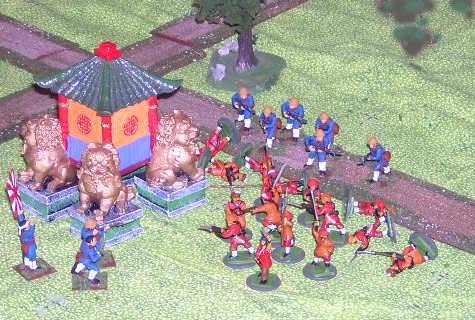
Photo by Ed Sansing
Special rules for wounded men
Each wounded man was diced for during the Rally Phase, to see the effect of medical care. The "owning player" rolled a D6 for each of his wounded, and the following results were applied immediately.
American Sailors or Marines who could reach one of the two gunboats received somewhat better medical care and perhaps a medicinal brandy.
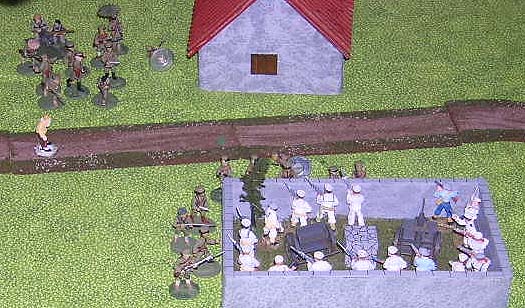
Photo by Ed Sansing
The U.S. sailors “liberated” a Chinese field piece after prolonged “back and forth” close combats in one of those “Chinese” garden areas built by Larry Brom and now owned by Jay Stribling. However, a few honorable Chinese peasants in another garden area TWICE kept another U.S. sailor unit from despoiling the tombs of their ancestors (and kept them from prying off gold ornaments from the tombs).

Photo by Ed Sansing
Japanese Naval Landing party troops celebrate after "Pacifying" a Chinese shrine.
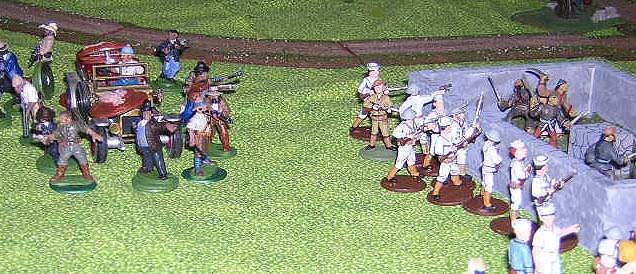
Photo by Ed Sansing
"Ohio Jones" with his valuable automobile and fossils, dedicated a foreign museum sneak by American Sailors who are trying to remove valuable grave markers from a Chinese cemetary. The Americans were kept out for the entire game by some Chinese peasants.
So who won this game?
The Ghurkas took over the whorehouse and received funds for "Protecting" the madam and the working girls. The game was won however by the U.S. marines who occupied the Standard Oil concession, thus receiving points for the delivery truck, the cash box, several previously looted items from a Chinese shrine (which they relieved from a Chinese Warlord group which laboring under the load) and then, to cap it all off, they stole the Japanese naval landing force’s Hotchkiss gun!
The umpire - Jay Stribling - paid each player in "Monopoly Money" at the end of the game.
Funds Disbursed:
|
Return to the Master Index of Photos and Games
Return to the Jackson Gamers' Homepage
Angelfire - Free Home Pages
Free Web Building Help
Angelfire HTML Library
htmlGEAR - free polls, guestbooks, and more!
Thank you for visiting The Jackson Gamers' pages at Angelfire. Please come back and visit again!